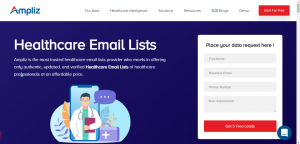Imagine this: you’re launching a campaign and you know that a specific product is only interesting to a certain segment of clients. AI analyzes the data, identifies the right audience, and suggests how to capture their interest.
In this article, we’ll talk about how to use AI to improve customer segmentation in healthcare B2B marketing. Why is this important? It’s simple: better segmentation means more targeted campaigns, which leads to more conversions and happier clients.
Boring? Not at all! We’ll show you how AI can sift through tons of data, uncover hidden patterns, and help you understand your clients better than ever before.
Key Strategies for Customer Segmentation in Healthcare with AI
Even if you think you already know everything about segmentation, AI brings a whole new level of understanding. Let’s break down how you can improve your customer segmentation strategy in B2B healthcare today.
1. Behavioral Data Analysis
First up is analyzing behavioral data. AI can sift through massive amounts of information in no time. You’ll quickly understand how your clients behave on your website or app. From the number of visits to specific actions like downloading documents or registering for webinars, everything matters. Missing out on this data means missing out on great opportunities.
What to do? Use tools like Google Analytics and machine learning algorithms to collect and analyze data.
For example, suppose a hypothetical company sells medical equipment. AI might notice that a group of users frequently visits pages about ultrasound machines and downloads related documents. This signals that these customers are particularly interested in this category. You can create a segment for these users and send them targeted offers for ultrasound machines.
Source: https://www.dataaxleusa.com/blog/customer-segmentation-statistics/
2. Cluster Analysis
Next, let’s look at cluster analysis. This method groups your clients based on similar characteristics and behaviors. AI can automatically create these clusters, making your segmentation accurate and straightforward.
Divide your clients into groups based on business size, location, or specific activities. For instance, large hospitals in metropolitan areas and small clinics in rural areas will fall into different clusters. Naturally, you’ll need to create very different, more targeted marketing campaigns for each group.
How to implement it? Use algorithms like K-means or DBSCAN for data clustering. These algorithms will help you understand what customer groups exist and how to best target them.
Remember, about 77% of marketing bang-for-buck comes from campaigns that are well-targeted, finely tuned, and right on the money.
3. Behavior Prediction
AI doesn’t just analyze current data; it also predicts future behavior. This means you can not only react to current needs but also anticipate what your clients will need in the future.
If data shows that clients who purchase certain equipment often return for additional services after six months, you can prepare a marketing campaign and offer these services before they even reach out to you.
How to implement it? Use predictive analytics models like regression analysis or recurrent neural networks (RNN) to forecast customer behavior. Tools like TensorFlow or PyTorch can help you create and train RNNs, while Scikit-learn is useful for regression analysis. A good open source password manager can also come in handy.
4. Content Personalization
Alright, so you’ve segmented your clients, but now you need to create personalized content for each segment, right?
This means each client should get info that perfectly matches their interests. Clients who are into new tech in medical equipment should get regular updates and news about the latest innovations. Those who are more budget-conscious can receive info about discounts and promotions. How likely is it that the first group will trash your email if you send them deals they don’t care about?
Use recommendation systems based on machine learning algorithms. Automate the personalization process. For example, collaborative filtering can help recommend content based on the behavior of other users with similar interests.
Check out recommendation systems like Amazon Personalize or Google Recommendations AI to automate personalization. Also, look into tools for collaborative filtering, like Apache Mahout or TensorFlow.
5. Automating Marketing Campaigns
It’s 2025, and you can automate pretty much everything, including your entire marketing campaign. Here’s how it can work:
Once AI segments your clients based on interests and behavior, it can automatically launch marketing campaigns. New clients can get welcome emails, while regular ones get exclusive offers and updates. Check this out: campaigns that aren’t targeted see a 50% lower click-through rate compared to those that are finely tuned and aimed right at the bullseye.
The big question: How to implement it and what to use? Start by integrating marketing automation tools like HubSpot or Marketo. This will let you set up automatic email sends and manage campaigns based on the AI-generated segmentation.
We often see people thinking of AI for customer segmentation in B2B healthcare as just an improvement in targeting accuracy. But it’s more than that. It’s a way to make marketing more cost-effective and build long-term, mutually beneficial relationships with clients.
Best Practices for Implementing AI in Customer Segmentation
So, you’re implementing AI for customer segmentation as it’s one of the technology trends in healthcare industry.. Here are a few key rules to make sure everything goes smoothly. Let’s break it down.
1. Start with Clear Objectives
Before you start, clearly define what you want to achieve with AI. Increase conversion rates? Improve customer experience? Enhance order processing efficiency for medical equipment? Improve inventory management? Clear goals will help you focus and use AI effectively. For example, if your goal is to increase conversions, set up AI to create personalized offers for different customer segments.
Let’s say your goal is to improve inventory management for medical equipment. Use AI to analyze sales and supply data. For instance, AI can predict an increase in demand for specific medical devices (like ventilators) based on seasonal trends and epidemiological data.
An AI system can automatically place orders for additional equipment from suppliers in advance to avoid shortages. The system can also recommend optimal order times and quantities for each customer segment.
- Analyze current metrics and identify key areas for improvement.
- Use analytical tools like Google Analytics or internal CRM systems to get a detailed picture of customer behavior.
- Set specific key performance indicators (KPIs) to measure your goal achievement. For increasing conversions, this might be conversion rate, the number of new clients, or average order value.
2. Invest in Quality Data
Would you believe it? Only 4% of companies bother to slice and dice their data in multiple ways for better targeting. Data is the fuel for your AI. Bad data means bad results. Gather data from all possible sources:
- Web Analytics. Use tools like Google Analytics to track how medical institutions interact with your site. Look at visit frequency, time spent on pages, bounce rates, and more.
- CRM. Systems like Salesforce or HubSpot provide data on interactions with medical institutions, order histories for medical equipment, inquiries, and complaints.
- Social Media. Use tools like Hootsuite or Sprout Social to see how medical institutions and professionals engage with your brand, what they say, and their preferences.
Make sure to clean your data to remove any gaps and duplicates. For example, if your database has a lot of incorrect or duplicate entries, AI can make incorrect conclusions. What does this lead to? Ineffective decisions.
- Use algorithms to detect and remove duplicate entries. Identify duplicates by unique identifiers (like email addresses or phone numbers).
- Find where there are gaps in the data and use methods like imputation to fill in missing values based on existing data.
- Identify and correct incorrect data. For instance, if the “Order Date” field has a future time, that’s an obvious mistake that needs fixing.
3. Collaborate with Data Scientists
Let’s be real: working with data isn’t a walk in the park. Bring in experienced data scientists who can help choose the right algorithms and set up models. It’s important they understand the context of your business and can tailor their solutions to your needs. Ideally, hire someone with experience in B2B healthcare.
Imagine you need to accurately forecast the demand for medical supplies like masks and gloves. Call in experienced data scientists to use advanced algorithms, like gradient boosting, to analyze past orders, seasonal trends, and epidemiological data. These smart models can accurately predict what will be needed and when, so you’re always stocked up and don’t run out of supplies.
In the end, these solutions help you maintain optimal inventory, reduce costs, and improve customer service, making your B2B medical business more efficient.
4. Ensure Ethical Data Use
Ethical data use isn’t just a fancy word. Follow all regulatory requirements and adhere to principles of transparency and confidentiality.
- Working with patient health data? Ensure your systems comply with GDPR or HIPAA. When collecting data through your website, use encryption. Store data in encrypted form on secure servers, limit access to only necessary staff, and regularly update security measures.
- Develop a clear privacy policy and post it on your website so customers know how you protect their data. Train employees on how to handle data correctly and why it’s important.
It might seem like just a few steps, but it’s actually a complex aspect of the job. If you want to run a business smoothly and legally, play by the rules.
Conclusion
Using AI doesn’t just improve segmentation accuracy; it also helps predict what clients will need in the future. This means marketers can quickly adjust their approaches and offers, making clients more satisfied and loyal.
But beyond the cool capabilities of AI, remember the rules—both ethical and legal. These aren’t just formalities. They’re the foundation for building sustainable relationships with clients and maintaining your company’s reputation.
So, using artificial intelligence for customer segmentation in B2B healthcare marketing is not just an innovation but a truly strategic decision.



